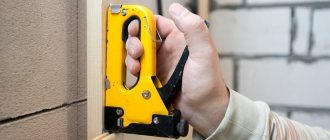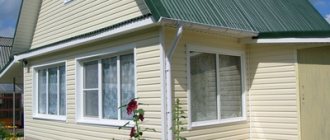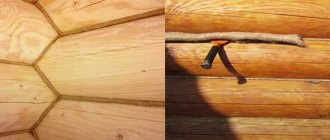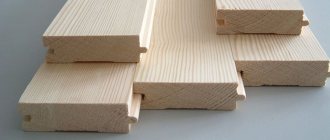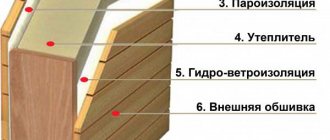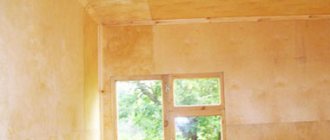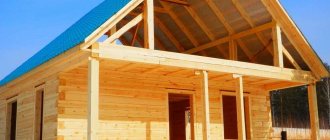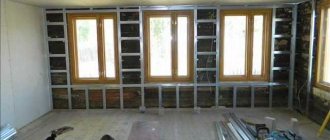Cladding materials have always been in great demand. One of their varieties is lining. It has established itself as a high-quality product with many positive properties. There is a wide variety of profiles on the market, which allows you to create different textures and attach panels anywhere. Almost any type of wood can be used as a primary raw material. Lining has become a common material for finishing steam rooms, but it can also be found in expensive private homes. The styling pattern is selected individually. It can be horizontal, vertical, diagonal, combined. Complex configurations are popular these days. Eurolining has a good reputation. It has a neater appearance and improved properties. If you have basic knowledge, clapboard cladding can be done on your own.
Advantages and disadvantages of finishing
Initially, lining was used to decorate train interiors. Even then, people paid attention to its ability to soften changes in humidity and temperature. It was quickly attached with profiled joints - this is another plus. Then the lining was improved: the shape and grooves changed, and the design characteristics improved. Finishing with modern lining has many advantages. First of all, this is the convenience and speed of installation thanks to the tongue-and-groove system. Another advantage is environmental friendliness. And one of the main advantages can be considered a low price with a fairly presentable appearance. Clapboard finishing has several negative aspects. The material can be spoiled by parasites. Rotting also causes deterioration in the appearance of the cladding. Wood also absorbs a lot of moisture and heat and deteriorates because of this. However, in doing so it improves the indoor air.
Recommendations
Installation of the lining must be carried out in accordance with the rules. At this stage there should be no omissions or defects, otherwise the cladding may turn out to be fragile and will not last long.
Between the planks and the base (wall, facade, ceiling, etc.) there must be a ventilation gap of 1-2 centimeters. It is often overlooked during installation, covering the ventilation space with thermal insulation. For normal ventilation, an empty space must be left between the installed lining and the ventilation layer. If this is not done, the material will begin to get wet, crack, and bend.
If during the work no space was left for ventilation, the casing must be dismantled. If there is insulation, there are 2 ways to create a ventilation gap: you can remove part of the insulation or “build up” the frame, thereby increasing the distance between the base and the sheathing.
During the installation process with your own hands, when aligning the eurolining strips, you must act extremely carefully. In order not to spoil the material when tapping their ends, it is necessary to correctly calculate the impact force. In fact, due to the fear of breaking off the groove, small distortions of the planks are often left during installation. This should not be allowed - the material must be laid perfectly evenly, exactly parallel to the starting plank. Otherwise, the distortion will only increase, causing the entire cladding to be crooked.
If the boards are already installed skewed, you need to find the one that caused the discrepancy. All sheathing installed after it must be removed. Then the uneven plank is leveled and the lining is mounted again.
Wood expands when heated and contracts when cooled. To compensate for the transformation of its dimensions, when laying the sheathing along its contour, a space of several millimeters is maintained. If the installation is carried out without a gap and the boards rest against the walls, the sheathing will be subject to deformation over time. To correct such a mistake, you need to dismantle the baseboards and trim the edges of the strips a little. So, when facing walls, the outer planks should not reach the corners by 5-6 mm. The same thing applies to joints with ceilings and floors.
Often the lining is fixed to the frame using clamps (brackets of a special configuration). Meanwhile, conventional staples can only be used when it is necessary to sheathe interior and dry rooms. For external cladding, as well as for cladding rooms with high humidity, it is better to use nails or self-tapping screws. In such cases, standard staples do not provide a very reliable fastening and the skin becomes deformed as the wood becomes damp, as well as under the influence of sudden temperature fluctuations.
If the cladding of a room with high humidity or a facade is done using not very strong brackets, the fastenings must be strengthened. The easiest option is through fixation using nails or self-tapping screws. It is necessary to take into account that in this situation their caps will be visible on the surface of the skin. If this is unacceptable, then the lining must be removed and laid again using more reliable fasteners.
In accordance with the regulations, eurolining must be covered with protective agents after installation. In fact, this is not always done; as a rule, the material performs its functions without special coating. The result of this is the appearance of fungal growths on the surface. If the tree has not yet deteriorated, it is necessary to apply a protective substance to it as soon as possible. If fungus has already formed, the surface of the boards must be treated with a special anti-fungal agent, and then applied protection. In some cases, before applying protection, the surface is sanded to remove damaged wood.
Types of lining
Conventional lining is characterized by the following dimensions: thickness - 1.2-2.5 cm, width - up to 15 cm and length - up to 6 m (this is basically what it was in the old GOSTs). Standard lining has a smaller tenon - 4-6 mm, compared to 8-9 for Euro lining. The humidity of ordinary material is 8-12%, 25-35%, the European version is up to 12%. The old type of lining is made from material with natural moisture. Eurolining is a high-quality cladding board for external and internal wall decoration. It masks imperfections well and is capable of leveling surfaces. In addition, it performs sound and heat insulating functions. Eurolining has certain fixed parameters. The thickness is 1.3, 1.6 and 1.9 cm. The width is 8, 10, 11 or 12 cm. The maximum length of the board is 6 meters, but this figure depends on the manufacturer and varies greatly in different cases.
Types of wood from which eurolining is made:
- oak;
- Linden;
- pine;
- spruce;
- aspen.
Work procedure
Wooden lining can be used to decorate living rooms of almost any design style, either completely or partially, see fig. In the latter case, lining can be an effective means of zoning a room, top left in Fig.
Living rooms decorated with clapboard
The walls are finished with clapboards in the following order:
- Preparing the building: if the walls are porous or cold (they conduct heat well) - insulation and waterproofing from the outside. Possibly also external decorative cladding. Neglecting this point will bring all efforts to create beauty inside to nothing;
- Choice of material – wood species, profile and width of the lining boards;
- Choice of cladding scheme: horizontal, vertical, diagonal, shaped;
- Preparation of the internal base surface - leveling, vapor/water insulation;
- Installation of sheathing under the cladding;
- Wall covering with clapboard, using standard or simplified technology. In terms of strength and decorative qualities of the cladding, they are equivalent, the differences are different, see below;
- Applying a protective coating to the casing;
- Installation of sockets, lamps and other devices built into the wall;
- Applying skirting boards to expansion gaps, corners of window slopes and door quarters.
Types of lining profiles
Variety is important in finishing, so manufacturers produce different variations and modifications of the lining. Traditional eurolining forms distinct seams after installation. If this type of lining has a rounded chamfer, then it is “Softline”. Its outer part is devoid of corners, which allows you to protect the wood from burrs and chips for a long time. "Softline" is well suited for saunas. The Shtil lining does not have a chamfer near the tenon, and, as a result, there will be no pronounced seams after assembly. The thickness reaches 2.5 cm, so it can be used for decorating facades. “Landhouse” is a lining with a complex rounded shape at the edges. Finishing with this coating will make the interior more “expensive”. Another interesting option is “Blockhouse”, which features a rounded front side. This material can be used to finish the surfaces inside log houses and facades.
Several more types of lining:
- "American". Has a sloping surface. The elements are overlapped.
- Double-sided. Both sides are obverse. It is used not only for finishing walls, but also for constructing partitions.
Painting after installation
Upon completion of the work on installing the finishing in your home, another important question arises - what solutions to protect the cladding of your house with, how to cover the lining to extend its service life, to avoid the appearance of insects, and also to protect against rot and mold?
It would be unreasonable to neglect such an issue, especially due to the fact that nowadays hardware and construction stores have a truly huge assortment. Therefore, it is very easy to choose any variation of impregnations and protective solutions for your lining.
Type of lining depending on the type of wood
The lining is made from coniferous and deciduous trees, as well as from exotic species (for example, mahogany). Among the coniferous species, it is worth highlighting spruce, pine, larch and cedar. Spruce is endowed with softness, which is important for making boards with rounded shapes. This material looks great in a modern interior. Pine lining is a budget option that has many important qualities, including high strength. Larch is one of the most expensive coniferous species. Cedar boards have a pleasant natural smell that has a beneficial effect on the body. Among hardwoods, the most popular are oak, alder and linden. Oak wood is a durable and sought-after material. Lining made from this wood is considered a classic option. Alder is suitable for use in damp rooms as it does not absorb moisture. Linden is very resistant to deformation and mechanical damage. Lining from it is relatively inexpensive.
Which material to choose
To decorate a house with clapboard from the inside, it is better to opt for the following materials:
- Tree;
- MDF panels;
- LDSP/LDVP;
- Plastic panels.
When listing the material, it was no coincidence that plastic ended up in last place, despite the fact that the cost-effectiveness and rich color palette, as well as ease of operation, are obvious. But environmental performance and resistance to mechanical damage relegate the quality of such cladding to last place. Another disadvantage of the plastic profile is its low fire resistance; already at a temperature of 100 ° C, the material begins to emit an unpleasant chemical odor, and with a further increase in temperature it can begin to smolder.
Metal lining is very heavy to decorate a room with. And in the summer, a room covered with such a profile will quickly and strongly heat up.
Wood is the most popular type of interior cladding. A chipboard product will have to be painted or coated with varnish that imitates the texture of wood. And this will lead to a delay in the progress of work, and will not give the desired result.
When choosing a wooden material, you should focus on the highest grades of lining - “Extra” and grade “A”. As a last resort, you can use “B”; class “C” material is only suitable for finishing utility rooms, such as a pantry.
Type of lining
There are 4 varieties:
- Extra;
- Class A;
- Class B;
- Class C.
The boards are sorted depending on the presence of resin pockets, pronounced blueness, knots, cracks, and roughness (poorly treated areas). The extra grade is characterized by the complete absence of prostrog or minor defects on the front side. There may be one light knot per linear meter. For class A, the presence of microcracks and small untreated areas is allowed. At the longitudinal ends, cracks no longer than the width of the board are allowed. There should be no more than a fifth of all boards made of core profiles. It is acceptable to have 3 knots on one linear meter. As for class B, the presence of 2 falling knots is allowed on one such board. Cracks up to 3 cm are allowed on the front side, and cracks of any size on the front and back sides. All panels can be made from core, with resin pockets. Class C includes all boards that are not included in the categories from extra to class B, but are suitable for use. Rottenness is not allowed.
Treatment with paint or varnish
In order for the room to take on a finished look, the wooden lining is painted with varnish or paint.
These different bases have different composition and structure of the substance. There are varnishes: Acrylic
Acrylic varnish dries quite quickly. It is easy to apply to the surface. Protects from moisture and dust. Easy to clean.
Polyurethane varnishes
Polyurethane varnish is the most profitable option. There are quite a lot of options to choose from in stores. The color range varies from light to dark tones. When choosing this product, you must purchase a primer in the appropriate color.
Alkyd varnishes
This varnish takes a long time to dry and leaves behind a pungent odor that does not immediately disappear. To speed up the drying process, there is a specially developed product. One of the advantages of this varnish is the creation of a microfilm on the surface of the wood.
Acrylic-polyurethane substances
Made from recycled resin. The composition includes a urethane component, which dries quickly and protects the coating from aggressive environments.
Water based
This varnish is a more environmentally friendly product compared to others. Dries quickly and washes well. Contains water-repellent components. The price of this product is much higher, but the safety of use makes it the most popular in use.
Where to apply
Clapboard finishing is often used in steam rooms and other bathhouses. In this case, choose panels made of linden and alder (for steam rooms) and coniferous wood (for other places). These types of wood are endowed with healing properties, thanks to substances that are released when heated. Boards with knots cannot be used in steam rooms, as the corresponding areas become hotter. For a good aroma, it is recommended to install several pine boards in the area of the stove. The lining treated with protective compounds is suitable for cladding facades; the type of wood in this regard is not particularly important. Interior decoration is a complex task; panels in a uniform color scheme are required. Mahogany lining is used for cladding walls in expensive mansions. The panels are also used to make partitions to divide space: both in apartments and in open areas.
Examples of cladding
- There is an opinion that lining is more suitable for a bathhouse or cottage than for an apartment or cottage. This misconception is successfully refuted by designers who harmoniously integrate wood cladding into a wide variety of trends and styles.
- Wood lining in the interior harmoniously combines with wallpaper, tiles, and plaster. With a professional combination of textures, you can create a stylish and elegant interior.
- Lining can become an integral part of an interior in Scandinavian style. In this design, it is in harmony with artificial or natural stone and large beams on the ceiling.
- Anyone who is in love with Provence will certainly suit the walls made of wood in natural tones. In this option, the combination of wood with plaster and rough board floors looks nice and relaxed.
- Another style that requires the use of natural wood cladding is Russian. The walls, lined with a block house, look like the walls of a log house.
- You can also use lining in high-tech style. In this version, the materials are painted in neutral white or gray colors and are used as a background for rich accessories.
- Fans of minimalism will most likely like the combination of lining with a strict cladding made of ceramics and stone.
See below for more details.
Sheathing schemes
There are two ways - using external fastening and hidden. With the external method, the boards must be fixed with fasteners. In the second case, the panels are attached to the sheathing from the groove side, where there is a joint with a tenon. The appearance with this option will be more aesthetic. The lining can be mounted vertically, horizontally and, if necessary, in a non-standard way. When laying panels horizontally, the teeth must be directed from the lower element to the upper one, and not vice versa. When sheathing a log wall, staples and nails for them and lathing are used. To clap a room with smooth walls, you need to use bars. They are placed at a distance of no more than 50 cm between adjacent elements and perpendicular to the panels. The cladding is framed with decorative skirting boards and fillets
Basic fastening methods:
- nails;
- screws;
- staples;
- kleimers.
Preparatory stage
Cladding inside a wooden house is only possible if all external work has already been completed. A wooden house, despite all its obvious advantages, has several disadvantages that should definitely be taken into account before starting finishing work.
Of course, first of all, this is high humidity, which means the appearance of mold and other harmful organisms. Therefore, before you start covering, the walls need to be carefully prepared.
The lining is always installed on dry and perfectly smooth walls, otherwise any defect will spoil the final result of the entire work.
All walls must first be treated with a special agent against fungus and mold. To do this, you can use modern antiseptics, which are sold in any hardware store. All walls need to be treated, even though they are not affected by mold.
If necessary, before installing the lining, you can additionally insulate the walls and take care of additional sound insulation. For example, you can use a material based on mineral wool or use a special vapor barrier film.
Any insulation or special foil must be overlapped directly onto the wall itself. You can strengthen them using a special stapler. The bars will need to be attached on top of this material, and not vice versa.
After the walls are prepared, you can move on to the next stage - making the frame, onto which the lining itself will then be attached.
The frame can be made of metal profiles or wood. If you plan to install the lining vertically, then the frame beams should be attached horizontally and vice versa.
It is recommended to pre-prepare slats that will become the base of the frame. Choose them with a width of no more than thirty millimeters.
The first rail, regardless of how the lining will be attached, must be installed strictly vertically. When securing the rail, for example, with self-tapping screws, be sure to use a plumb line. In order for the entire frame to be made in a single plane, you can use threads that need to be pulled between the slats. By following the threads, you can easily install the remaining elements for the frame.
When carrying out the lathing, remember that the distance between the slats should not be more or less than fifty centimeters. After everything is ready, the sheathing must be treated with a special antiseptic.
So, the preparatory stage is completed. Next, you should begin installing the lining itself.
How to sheathe it yourself
You will need to complete the following stages of work:
- Prepare the lining.
- Prepare the wall.
- Assemble the sheathing.
- Attach the clapboard to the lattice frame.
- Finish the covering with skirting boards and, if necessary, other elements.
The panels are processed first. Depending on the place of application, any class of lining can be processed. It is always necessary to prepare the surface of class C products. The same applies to lining made by yourself. Preparing the walls consists of leveling them and applying markings for the sheathing. It is not necessary to level it; instead, you can do other manipulations. The crucial point is the installation of the sheathing. The timber itself and the distance between the elements are selected. The configuration completely depends on the planned method of laying the lining. Different approaches are used to fix the panels. The main thing in the work is caution, because inaccurate driving of the fastener can lead to the appearance of serious defects in the material. When the sheathing is ready, installation of baseboards and finishing begins.
How to prepare the lining
If necessary, the panels are treated with fine-grained sandpaper to eliminate roughness. Further processing begins with cleaning the surface of the material. If you plan to apply wax or varnish to the lining, stain is first used. It will preserve the color of the wood for a long time. There are 3 types of stain: oil-based, alcohol-based and water-based. Antiseptics will protect the wood from moisture penetration and mold. If the installation location is a bathhouse, waxing will be required. It is applied in small quantities, in the direction of the fibers. This procedure must be repeated several times. Then the products are polished. Among other things, the color of the boards will become deeper. There is a large selection of wax impregnations on sale, which are also suitable for preparing lining. The last stage is applying varnish. You will need at least 2 layers. The material must be perfectly dry before installation.
Grease stains can be removed using a 25% acetone solution.
Preparing the walls
You will need to make markings on the wall for the sheathing. This action is performed using a pencil and level. The configuration of the cladding and the direction in which the lining will be placed are determined in advance. The bars are always placed perpendicularly. If everything has already been decided about this nuance, you can start treating the walls with antifungal agents and marking the surfaces. If something happens, the pencil is replaced with chalk. The width of the sheathing step is selected depending on the purposes. For strength, it is advisable to make it as small as possible. Usually this figure is in the range of 35-60 cm. If in the future it is planned to insulate a room, the step is determined based on the size of the insulating material and should be slightly less than it. To ensure that the frame structure is level, you will need to use a plumb line and fishing line. A visualization is created, along the edges of which bars are then placed.
We create a sheathing for fasteners
This is one of the most important stages, which has a significant impact on the final result. Only sometimes the lining is attached directly to wooden walls; in other situations, lathing is necessary. At the very beginning, we select the timber. For this sheathing, a block with a cross section of 40×20 mm is the best option. We install the frame one level at a time. If necessary, we level each individual wall. You can use another method - determine the most protruding place on the wall. Then a small piece of timber is placed there and the sheathing is mounted from it. From this point the thread is pulled parallel to the planned direction of laying the panels. At the extreme points of the wall, 2 load-bearing beams are placed. If necessary, install spacers between the wall and the beam. If a row of lining will be mounted from 2 boards, another beam is needed at the junction.
Other important nuances:
- when securing the structure, you need to check the level;
- if there are door or window openings, the beams must be fastened around them;
- Installation of lathing on the ceiling is done in the same way as on the walls.
Fixation methods
The lining is secured using staplers, clamps or fasteners (screws, nails). During installation, care must be taken to avoid splitting the wood and causing cracks. Full insertion of the nail head into the material and accuracy of work are ensured with the help of a hammer. When installed in a hidden way, the panels are nailed to the frame at the junction of the tongue and groove. The simplest and easiest assembly method is to fasten with small nails in any places, but it is better to prefer a neat method that involves hammering nails into the grooves to hide the connection. The highest quality fastening is ensured by metal clamps. They come in different sizes, shapes and are designed for a certain board thickness. The fasteners are connected to the sheathing on one side, and cut into the grooves on the other.
Fastening the lining to the ceiling requires careful steps, so it is better to do this together with a specialist!
The process of fastening the lining
If the sheathing is installed correctly, the process of installing the lining will go without complications. A level may be needed when attaching the first panel. The first question before installation is which side to start laying the boards on. You can determine the answer by finding out how smooth the surface is. If it corresponds to the level, then you can start laying from any side: top, bottom, right, left, corner. The first board is then placed level. If the surface is slightly “overwhelmed” or some corner is uneven, the boards cannot be installed this way. Otherwise, they will visually emphasize the curvature. The lining will need to be assembled in a different way. The first board is attached flush to the corner, the rest - with a slight inclination in the desired direction. Sooner or later some panel will become level. All boards “fill up” to the same extent. The first one needs to be placed with the spike towards the corner.
Rules for installing skirting boards on a wall with lining
For an aesthetic appearance, the sheathed walls are decorated with floor and ceiling skirting boards. Sometimes they need to be mounted on the wall (corner). When finishing corners, they are guided by the following rules: if there is an adjacent unsheathed wall, then the plinth is installed on it, and when placed between two sheathed ones, it should be attached to the shorter one. These measures should not prevent thermal deformation and drying out of surfaces that are most susceptible to them. If the wall is decorated with clapboard, then the baseboards are fixed using finishing nails. They hammer it through the body, the narrow cap goes into the mass. These areas are then treated with a wax pencil. If the surface is not flat (for example, log), nailing a regular baseboard will not always be possible. Gaps may remain. It is likely that in the corners the baseboards will not meet at all. Instead, you can use flat platbands. They fit tightly on the wall, and you can make them yourself, including from clapboard.
Preparation for installation
Before installing the lining, it must be thoroughly treated with chemicals that will prevent mold and also prevent the appearance of rot and pests. The material must dry well and sit in the house for at least a day so that the wood gets used to the atmosphere of the room.
Next, you need to make internal markings of the room, determine the location of sockets, switches and take into account window and door openings. This should be done to avoid unnecessary consumption of material and masking of unwanted joints.
DIY installation tool kit:
- Hammer;
- Level;
- Kern;
- Stapler;
- Hacksaw for metal;
- Plumb;
- Screwdriver;
- Screwdriver.
But you should be prepared for the fact that more tools may be required; this list does not include consumables such as screws, dowels, varnish and various putties.
Decorative finishing methods
If installation is carried out in a hidden way, it is recommended to use decorative fasteners. A hammer will ensure accurate fixation and decoration of the nail in the wood. You can decorate the corner between the boards using treated timber - this way there will be no gaps in the opening. If the natural color of the wood does not fit into the interior or does not add any color, then the lining is coated with paint. It’s better to match the decor or white. The nail heads that secure the starter board are covered with decorative corners. If there are no decorative slats, then the tops of the fasteners are removed with side cutters. All joints, internal and external corners must be closed. Bottom and ceiling plinths are also used for decoration. The interior can be radically changed by installing false beams on top of the lining.
Facade
In order to finish the facade in a horizontal direction, it is recommended to carry out work from the bottom up. The first plank is mounted with the tenon down and attached to the sheathing. The second panel is installed so that its tongue fits into the groove of the first, after which it should also be secured to the sheathing. All subsequent panels are mounted in a similar manner.
Fixing the lining onto the sheathing can be done using self-tapping screws, nails, construction staplers, as well as specialized fasteners. It wouldn’t hurt if the fasteners passed through the groove strip when installing the board, then it would be invisible. When installing each panel, it is necessary to strictly control the accuracy of its location - it must stand parallel to other boards. Distortions and displacements are unacceptable
It is also important that the boards are located strictly in the same plane, that is, they should not be higher or lower relative to each other
For door and window openings, wall joints, specialized skirting boards, profile corners and strips are used. The second option is to install the lining strips perpendicular to the base of the facade. The boards are installed and fixed in a vertical position. For wall joints, two planks are used, which are placed at the desired angle. Door and window openings are designed in a similar way (one plank covers the slope, the second bases the platband).
In some cases, it is necessary to use a double frame for eurolining. For this, the bars are nailed in two layers, the top one being made perpendicular to the bottom one. Reinforcement of the frame is required on large facades, where the own weight of the cladding is large and the load on the supporting structure is increased.
It is better to varnish and paint the lining after completion of installation, and treatment with protective agents both inside and outside should be carried out before installation.
When covering the facade, lining can be used in conjunction with other materials. This will give the exterior of the house a more expressive look. You can also use lining of various colors.
Useful information
Both private houses and apartments, bathhouses, public institutions and utility rooms are often lined with clapboard. You can sheathe the eco-friendly and convenient material not only on the walls, but also on the ceiling. In essence, lining is panels of different lengths and widths, sometimes with grooves and locks (tenons) along the edges for better fastening. It is attached to a special sheathing, and there are several methods of attachment, which we will talk about a little later.
Initially, the finishing of the premises was carried out only with lining made from different types of trees; the price of the material varied depending on the value of the wood. A little later they came up with MDF - the same panels, but made from glued pressed chips. The environmental friendliness remained, but the weight of the material was significantly reduced, and installation became simpler and easier.
Treatment with paint or varnish
In order for the room to take on a finished look, the wooden lining is painted with varnish or paint. These different bases have different composition and structure of the substance. There are varnishes:
Acrylic
Acrylic varnish dries quite quickly. It is easy to apply to the surface. Protects from moisture and dust. Easy to clean.
Polyurethane varnishes
Polyurethane varnish is the most profitable option. There are quite a lot of options to choose from in stores. The color range varies from light to dark tones. When choosing this product, you must purchase a primer in the appropriate color.
Alkyd varnishes
This varnish takes a long time to dry and leaves behind a pungent odor that does not immediately disappear. To speed up the drying process, there is a specially developed product. One of the advantages of this varnish is the creation of a microfilm on the surface of the wood.
Acrylic-polyurethane substances
Made from recycled resin. The composition includes a urethane component, which dries quickly and protects the coating from aggressive environments.
Water based
This varnish is a more environmentally friendly product compared to others. Dries quickly and washes well. Contains water-repellent components. The price of this product is much higher, but the safety of use makes it the most popular in use.
Mounting options
Next, you need to choose how the lining will be attached. The planks are connected to each other by grooves, but they must also be attached to the sheathing.
You can do this in 2 ways:
- Using a clamper. This is a mounting bracket with 2-3 holes. It is put on the lining and fixed with nails, screws or staples. Installation begins from the center of the wall. Its main advantage is that the kleimer does not damage the lining.
- Using self-tapping screws or nails: the first ones are screwed in at an angle, the second ones are driven in. To avoid rust, it is better to choose galvanized or copper nails. Unfortunately, the metal will begin to rust, and leaks may also appear at the fastening sites.
Claymer for clapboardSource mainavi.ru
You can easily see how to properly line a bathhouse with clapboard from the inside with your own hands. The lining can be mounted horizontally or vertically. The first method is more suitable for saunas, where the humidity is low, the second - for Russian baths, where there is high humidity.

